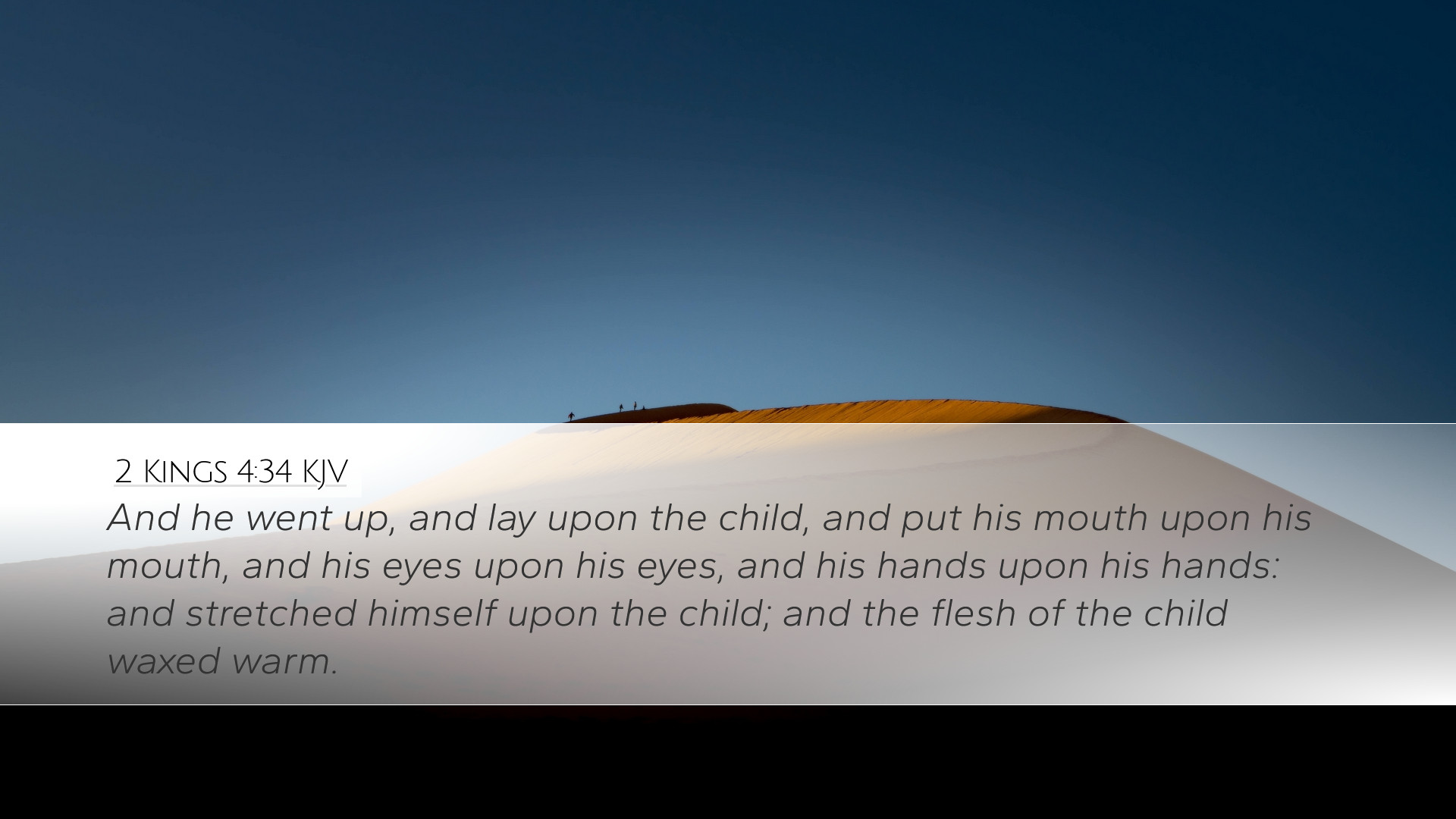Commentary on 2 Kings 4:34
2 Kings 4:34: "And he went up, and lay upon the child, and put his mouth upon his mouth, and his eyes upon his eyes, and his hands upon his hands: and he stretched himself upon the child; and the flesh of the child waxed warm."
Introduction
This passage reflects the miraculous ministry of Elisha, the prophet, and demonstrates God's power over life and death. The narrative depicts the prophet's compassion and his willingness to engage directly in the restoration of life, revealing profound theological themes about the nature of God’s intervention in human suffering.
Contextual Background
The context of this miracle is essential to understanding Elisha's ministry. Following the prophetic lineage of Elijah, Elisha's miracles and acts serve to substantiate God's ongoing covenant with Israel and His concern for His people. The story unfolds after a preceding narrative where Elisha is shown to care for a Shunammite woman who provided for him. This relational dynamic sets the stage for the intimate, compassionate rescue of her child.
Exegesis of the Verse
In this verse, Elisha engages with the deceased child in a very physical and direct way:
-
Process of Resurrection: Elisha's action of laying upon the child symbolizes an act of imparting life. The physical contact signifies more than mere ritual; it illustrates the profound mystery of divine agency in restoring the dead to life.
-
Symbolic Actions: The description of mouth to mouth, eyes to eyes, and hands to hands illustrates complete identification with the child's plight. This may signify the prophetic role in taking upon oneself the suffering of others, which is akin to the intercessory role found throughout Scripture.
-
Divine Intervention: The warmth returned to the child's body symbolizes the reanimation of life, affirming that God is the source of life and has authority over death.
Theological Implications
The actions of Elisha convey several theological implications that are significant for deeper study:
-
The Nature of God: This passage underscores God's sovereignty and compassion. Elisha acts as a conduit for divine power, highlighting how God engages in human situations, particularly in moments of profound loss and despair.
-
Faith and Response: The Shunammite woman's faith in calling for Elisha in her grief suggests the importance of faith in action. Her response to her tragedy was to seek the prophet, reflecting a belief in God's ability to intervene.
-
Life Restoration: The warmth that returns to the child is a foreshadowing of the resurrection promises that permeate the biblical narrative. It anticipates greater redemptive acts in the New Testament where Christ Himself claims the resurrection and the life (John 11:25).
Contributions from Public Domain Commentaries
Matthew Henry's Commentary: According to Matthew Henry, this story reflects God's graciousness not only in the miracles but also in providing a prophet who embodies His will and care. Henry emphasizes faith's role where the Shunammite woman exemplifies trust in God through her actions.
Albert Barnes' Notes: Albert Barnes points out that Elisha's actions parallel those of Elijah when he restored the Zarephath widow's son, showcasing a continuity in prophetic ministry. Barnes further notes the significance of the physical touch which acts as a conduit for divine healing, a theme prevalent in the Gospels as well.
Adam Clarke's Commentary: Adam Clarke discusses the practical aspects of this miracle, noting how Elisha's prophetic ministry illustrates the emotional and physical caregiving role of prophets. Clarke elaborates on the emotional intensity of the scene, emphasizing the connection between the prophet's actions and the broader theme of life amidst death in biblical literature.
Conclusion
The miraculous act of Elisha in 2 Kings 4:34 not only reflects God's power to bring physical life but also serves as a poignant metaphor for spiritual resurrection. The interactions between the prophet and the child invite readers to explore themes of faith, hope, and divine intervention in human despair. Pastors and theologians are encouraged to use this passage as a source of encouragement and teaching about God's unfailing attention to those who suffer, rooted in the biblical narrative that ultimately points toward Christ’s redemptive work.


